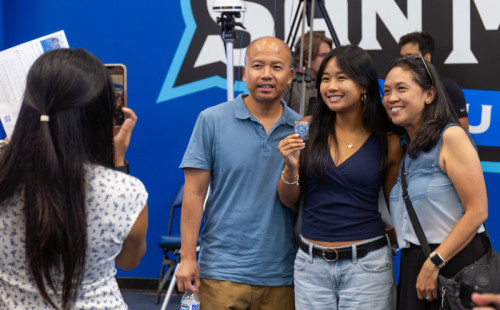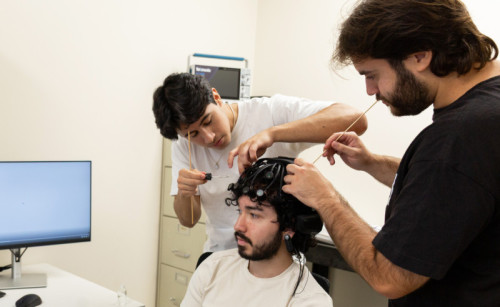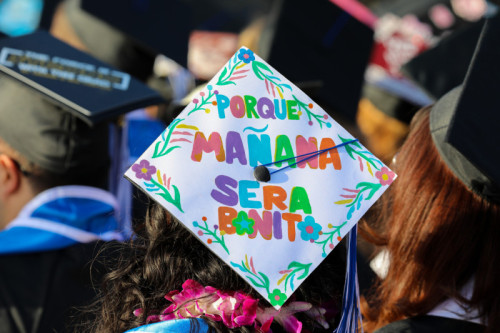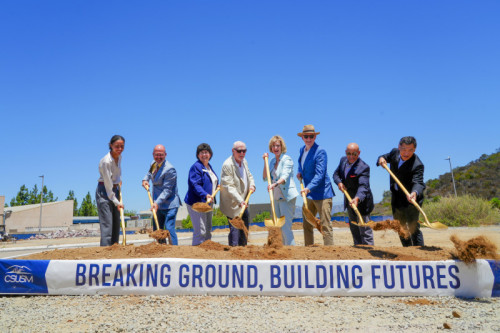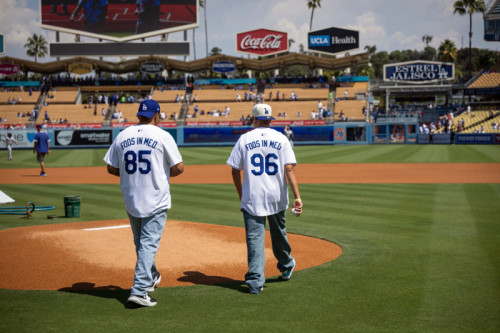Alumna's Journey: Student to Teacher to Proud Parent
25
February
2025
|
08:00 AM
America/Los_Angeles
By Eric Breier
"; items += "
"; items += "
"; items += "
" + val['title'] + "
"; if(val['subtitle']){ items += "
" + val['subtitle'] + "
"; } items += "
"; if ((val['showpublishdate'] !== 0 && showPublishDateHeadlineSetting) || showPublishCityHeadlineSetting) { items += '
'; if (val['publishcity'] && showPublishCityHeadlineSetting) { items += '
' + val['publishcity'] + '
'; } if (val['showpublishdate'] !== 0 && showPublishDateHeadlineSetting) { items += "
"; items += "
" + date_month + "
"; items += "
" + date_day + "
,"; items += "
" + date_year + "
"; items += '
'; items += ' | '; items += '' + val['publish_time'] + ''; items += 'America/Los_Angeles'; items += '
'; items += '
'; } items += '
'; } items += "
" + val['message'] + "
"; items += "
Read more
"; items += "
"; items += ""; items += tags_items; items += multimedia_count; items += "
"; } }); items +="
"; if (1 > 1) { pp_jquery(".pp_blockheadlines_items-7190124").append(items); } else { pp_jquery(".pp_blockheadlines_items-7190124 .pp-headline-block").hide().css("opacity","0"); pp_jquery(".pp_blockheadlines_items-7190124").append(items); pp_jquery(".pp-headline-block:visible").animate({"opacity":"1"},300); } }); } pp_jquery(window).on('load', function() { /** * targets calcEqualHeights function (modules_v2h.js) * calculates consistent height for all visible items per block module */ pp_jquery('.pp_blockheadlines_items-7190124 .pp-headline-block').each( function() { PP_MODULES.calcEqualHeights(this); }); }); pp_jquery(document).ajaxComplete(function() { /** * when using block item nav button calcEqualHeights * function (modules_v2h.js) will be executed */ pp_jquery('.pp_blockheadlines_items-7190124 .pp-headline-block').each( function() { PP_MODULES.calcEqualHeights(this); }); });
Latest Newsroom
- University Welcomes More Than 17,000 StudentsCal State San Marcos welcomed more than 17,000 students, including the largest freshman class in university history of more than 2,700, to kick off the fall semester Monday. Official enrollment numbers will be available following the 2025 fall census in October. President Ellen Neufeldt expressed excitement and optimism about the new academic year during her annual convocation address to faculty and staff last Thursday. “As we think about the start of school, in this moment in time — now more than ever — it is important that we remember why we are here,” Neufeldt said. “Why we show up. Why we keep going. We believe in the power and the promise of higher education. And we believe in the mission of this university.” Neufeldt highlighted many of the university’s achievements over the past year, while also looking ahead to what is in store. That includes CSUSM’s fundraising campaign, the largest capital campaign in university history. The campaign aims to raise $200 million through philanthropic support and sponsored research to expand programs, fund scholarships, advance faculty work, and strengthen the infrastructure that drives social mobility and lifts the entire region. “This is not just about dollars,” Neufeldt said, “it’s about lasting impact.” New science building On July 31, CSUSM broke ground on its future Integrated Science and Engineering (ISE) Building, which will allow the university to respond to the critical need for STEM programs, including new engineering majors and enrollment growth. The ISE building is estimated to cost $110 million and will be funded through commitments from California State University and private support. It will cover more than 70,000 square feet over three stories. The first publicly funded academic structure on campus since 2014, it’s expected to open in fall 2027. Name for new housing project The new University Village Housing and Dining Project, which is expected to be ready in time for the fall 2026 semester, has been formally named Black Oak Hall and Kwíila Dining. The names were determined following thoughtful input from a campus naming committee and student representatives. Kwíila is the Luiseño word for “acorn” and was chosen to honor the local tribal heritage and the land on which CSUSM resides. CSUSM named to best colleges list CSUSM was named to the “Best Colleges in America 2025” list by Money magazine. CSUSM received a rating of 4.5 stars out of 5. The list, which includes 732 colleges, showcases the country’s top values, based on graduation rates, cost of attendance, financial aid, alumni salaries and more. Weeks of Welcome The annual Weeks of Welcome, which started Aug. 22, includes dozens of events for students to meet new people and kick off the academic year. Visit the Weeks of Welcome calendar for a complete schedule. Arts & Lectures for fall The university’s longstanding Arts & Lectures series recently released its fall lineup. This season boasts a diverse selection of five events. Attendees can reserve tickets online via the Arts & Lectures website. Summer highlights CSUSM was selected for the third straight year as an Angeles Higher Education Impact Award honoree. A new master’s degree program in clinical counseling psychology was approved by the CSU Chancellor’s Office to accept applications this fall. Edward Mills was appointed as interim chief enrollment officer, beginning his tenure on July 28. Cinthya Ippoliti started in her position as the new dean for the University Library on July 1. Two alumni were selected for the CSU Chancellor’s Doctoral Incentive Program, also known as CDIP, for the incoming 2025-26 cohort. Surfer and business student Tanner Vodraska captured his second consecutive national title at the National Scholastic Surfing Association (NSSA) Interscholastic Championships. Media Contact Eric Breier, Interim Assistant Director of Editorial and External Affairs ebreier@csusm.edu | Office: 760-750-7314
- Summer Scholars Project Fuses Engineering With NeuroscienceSoudeh Khoubrouy came to Cal State San Marcos two years ago with an unorthodox mix of expertise: a background in electrical engineering (in which she holds a Ph.D.) combined with a research interest in neuroscience (in which she has a master’s degree). Entering her third fall as an assistant professor of electrical engineering, Khoubrouy runs the Neural Signal Processing and Artificial Intelligence Research (NSPAIR) Lab, a small room in Academic Hall where she and a group of students work on projects fusing her two academic fields – using engineering skills to advance neuroscience applications. This summer, the NSPAIR team began a project that they hope could someday contribute to helping people with paralysis use brain signals to accomplish everyday tasks. As part of the long-running Summer Scholars Program on campus, the three students in Khoubrouy’s lab – Aleks Gonzalez, Moises Nelson and Manuel Villa-Hernandez – started modestly. They learned about the electroencephalogram (EEG) cap that Khoubrouy purchased through a Hispanic-Serving Institutions STEM grant during her first year at CSUSM. The EEG cap is worn over the head, where 32 electrodes connect to the scalp (non-invasively), measure brain signals and send them wirelessly to a computer. The students then learned how to interpret EEG signals and the type of software employed to process them. They discovered how eye blinking by the person wearing the cap can disrupt the signal and how to remove that interference. They also reviewed methods used for EEG-based brain-computer interfaces that will assist them in designing their human data collection and decoding the collected EEG signals. When the fall semester commences, the students will split into teams and continue the project as part of their capstones (all three are senior electrical engineering majors who are on track to graduate next May). Gonzalez and Nelson, joined by a third student, will work with the EEG cap – designing experiments for human subjects (mainly student volunteers), collecting data and applying machine learning and deep learning methods to decode the EEG signals. Villa-Hernandez, joined by two other students, will focus on the robotic arm – collaborating on the experiments for human subjects and designing an interface to allow the team to take brain signals from the cap and use them to control the robotic arm. Khoubrouy said the Summer Scholars students built on the efforts of previous students, who accelerated the training process by sharing their work and resources. But she also saluted the current students for diving headlong into a mostly unfamiliar discipline this summer. “They had to go outside their comfort zone, because the project was an interdisciplinary topic,” she said. “Before this, they were only focusing on electrical engineering, and this was more related to neuroscience. The literature that they studied is high-level papers written by scientists, Ph.D. students. I know it was really difficult for them to understand, and I was impressed by the progress they made.” Gonzalez is a two-time Summer Scholar in the NSPAIR Lab who has been mentored by Khoubrouy since his sophomore year. The first project he worked on involved training AI software to interpret brain waves and predict if the subject was responding to an audio or visual stimulus. The team next increased the complexity, presenting the subject only with a visual stimulus and trying to determine if it was a food or non-food image. “I've been able to see how the projects have grown from their simplest form to now moving to controlling a robotic arm, which has been cool,” Gonzalez said. The robotic arm features four joints and a gripper. This school year, the objective is to exert basic control – which joint to move and in what direction. In future years, Khoubrouy hopes to reduce the processing time to make it as close to instantaneous as possible. The ultimate goal of the multiyear project is to help people with paralysis to move prosthetic limbs or other devices using only their thoughts. “I know some labs have been working on it,” Khoubrouy said. “They have been very successful, but the goal is to make it more natural and faster and easier.” All three of the lab students are from the local area (though Villa-Hernandez was born in Ithaca, N.Y., where his father worked for Cornell University), and all three have caught the research bug to the extent that they intend to pursue a master’s or even doctorate in engineering. “It’s really nice to be given the opportunity to partake in undergrad research,” Gonzalez said. “That pushed me to want to go to graduate school.” For now, however, there are experiments to design, subjects to recruit – and a robotic arm to move. “It’s fun, it’s interesting,” Villa-Hernandez said of the project. “It’s learning new things that you’ve never seen before.” Media Contact Brian Hiro, Communications Specialist bhiro@csusm.edu | Office: 760-750-7306
- David T. and Dorris E. Staples Foundation Supports Art InternshipsA paintbrush, a stage, a story — the arts inspire innovation, evoke empathy and spark thoughtful conversations. Now, thanks to a generous three-year investment from the David T. and Dorris E. Staples Foundation, Cal State San Marcos students are turning creative passions into career pathways through paid academic internships. In partnership with CCAE Theatricals, CSUSM’s College of Humanities, Arts, Behavioral and Social Sciences (CHABSS) launched Pathways to Purpose, a career readiness program that provides structured, paid internships for students in arts education and theater arts. Future educators gain experience designing curriculum and teaching in Escondido elementary schools, while theater students gain an introduction to administration, performance opportunities and invaluable production experience through set design, prop creation and behind-the-scenes work on live performances. “While there are clear career paths in fields like nursing or business, the pathway for liberal arts students may not seem as obvious at first glance,” CHABSS Dean Liora Gubkin said. “For our students, especially those who are first-generation, paid internships open doors to opportunities that might otherwise be out of reach.” More than half of CSUSM students are the first in their families to attend college, often balancing academics with multiple jobs. For liberal arts students, especially those drawn to nonprofit and public-sector work, most internships are unpaid. Pathways to Purpose helps level the playing field by reducing financial barriers and offering real-world experience. Research shows that students who complete internships are more likely to graduate on time, secure employment and earn higher wages. And with eight out of 10 CSUSM graduates staying local, the program also strengthens the region’s cultural and educational landscape. “We’re proud to support CSUSM’s Pathways to Purpose program, which reflects the university’s commitment to student success,” said Joe Bowe, president of the David T. and Dorris E. Staples Foundation. “By combining paid internships, mentorship and career skills training, the program prepares students for meaningful careers in the arts and education while strengthening the local workforce.” The Staples Foundation’s support builds on a longstanding relationship with CSUSM. Over the years, the foundation has contributed nearly $500,000 to programs such as the Alliance to Accelerate Excellence in Education, the ASI Cougar Pantry, the School of Education and the university’s All-Steinway School designation – a tribute to co-founder Dorris Staples’ love of music. “We’re immensely grateful to the Staples Foundation and thrilled to collaborate with CSUSM,” said Julianna Crespo, executive director of CCAE Theatricals. “The arts are essential to building vibrant communities. Partnering with CSUSM to provide students with real-world experience ensures that the next generation of artists and educators can thrive and make a lasting impact.” With Pathways to Purpose, the Staples Foundation is helping shape the future of the arts at CSUSM, providing students with the resources they need to transform their passions into purpose-driven careers that will benefit our region for years to come. “Our vision is to expand this program across all liberal arts disciplines, giving every student a chance to apply their education in real-world settings,” Gubkin said. Media Contact Eric Breier, Interim Assistant Director of Editorial and External Affairs ebreier@csusm.edu | Office: 760-750-7314
- Career Twist: Alumna's Path from Kinesiology to Hospitality SuccessWhen Rachel Debber toured Cal State San Marcos as a high school student from Fresno, she wasn’t sure what her college experience would hold. What she found was a close-knit campus community, opportunities to grow as a leader and the unexpected start of a career she hadn’t planned. Debber graduated from CSUSM in 2016 with a degree in kinesiology. Today, she leads the team at Lilo, a 22-seat fine-dining restaurant known for its immersive tasting experience and coastal cuisine. Just 10 weeks after opening, the restaurant earned a prestigious Michelin star. “I didn’t even know hospitality could be a real career when I started,” Debber said. “But I quickly fell in love with it. That passion and the people I’ve met through this industry have made all the difference.” Debber planned to major in nursing at CSUSM, but after not being admitted into the highly competitive program, she shifted to kinesiology and fully embraced the opportunities the university offered. She spent four years on CSUSM’s women’s club lacrosse team, a sport she’d never played before college, and served on the campus orientation team. She said those experiences shaped her into the leader she is today. “I didn’t like not being good at something, so I worked hard at lacrosse,” Debber said. “That same hunger carried into management. I wanted to be better, and I was willing to put in the work.” Orientation team training helped her connect with people from all walks of life, a skill that now serves her well in the hospitality industry. “We spent a lot of time learning about different communities on campus and how to support them,” Debber said. “That still sticks with me. Now I manage a diverse team, and that kind of awareness is essential. I received good training from being on the orientation team. They would bring in a lot of different leaders on campus to teach you about their area, and that was beneficial.” After graduation, Debber faced a decision: return home to Fresno to save up for grad school or stay in San Diego and work. She chose to stay and unknowingly launched a career in hospitality. “My initial entry into hospitality was with the intention of going back to school for kinesiology or for health science,” Debber said. “But I decided that I really had a knack for hospitality. I didn't even know that that was a career option.” Her first role was as a host at Campfire in Carlsbad, where she helped open the restaurant in 2016. She worked her way up through various roles, eventually helping to open Jeune et Jolie as a bartender and rising to general manager. “I think a lot of people really struggled when I first started working in hospitality,” Debber said. “I had a lot of people telling me it's not really a sustainable career. I felt like I had a lot of societal pressure to move into a different direction.” However, Debber found a sense of purpose and community working in the restaurant industry. Now as general manager of a Michelin-starred restaurant at Lilo, she’s focused less on accolades and more on people. “I think the Michelin star is just a byproduct of all the hard work we put in,” Debber said. “What’s most important to me is that we’re providing a unique experience for people, that our books are full every night, and that our team is genuinely happy with what they do. “As a company, we really believe in making sure everyone’s time is well spent. That’s something I care deeply about in my role. So, for me, it’s less about the Michelin star and more about creating something meaningful.” Debber never could have predicted becoming the general manager of one of the most talked about restaurants in Southern California. But she credits every twist and turn along the way for helping her grow into the leader she is today. “I think the best things in my life have come from saying yes to something that scared me a little,” Debber said. “You don’t always have to know exactly where you’re going. Just be open, work hard and trust that it’ll lead somewhere great.” Media Contact Eric Breier, Interim Assistant Director of Editorial and External Affairs ebreier@csusm.edu | Office: 760-750-7314
- CSUSM Breaks Ground on Integrated Science and Engineering BuildingCal State San Marcos on Thursday broke ground on its future Integrated Science and Engineering (ISE) Building, which will allow the university to respond to the critical need for STEM programs, including new engineering majors and enrollment growth. Among the speakers at the groundbreaking ceremony were CSUSM President Ellen Neufeldt; San Marcos Mayor Rebecca Jones; Assemblymember Darshana Patel, who represents the district that includes CSUSM; Jackie Trischman, dean of CSUSM’s College of Science, Technology, Engineering, and Mathematics; and representatives from C.W. Driver Companies and HGA, the general contractor and designer of the building, respectively. The emcee was Leon Wyden, CSUSM's vice president of Finance and Administrative Services and chief financial officer. “It wasn’t too long ago when the idea of the Integrated Science and Engineering Building was but a hope and a dream,” Neufeldt said. “So it seems a little surreal that we have finally come to this day, about to break ground on the first state-supported academic building at CSUSM in more than a decade. I am filled with so much gratitude – this milestone reflects the dedication of our faculty, staff, students and partners who work tirelessly to support CSUSM’s mission of student success and social mobility.” The ISE building is estimated to cost $110 million and will be funded through commitments from California State University and private support. It will cover more than 70,000 square feet over three stories. The first publicly funded academic structure on campus since 2014, it’s expected to open in fall 2027. The ISE building will be constructed at the top of CSUSM’s campus, between Markstein Hall (which houses the business college) and the Arts Building. It will feature teaching and research labs, additional classrooms, student support areas, staff offices, a café and outdoor gathering spaces. “It’s an incredible honor to stand here with you today as we break ground on a building that represents not just bricks and mortar, but also a beacon of opportunity, innovation and the future of engineering and technology in our region,” Trischman said. “As dean, I’ve had the privilege of working closely with our remarkable faculty and staff, many of whom met tight deadlines with determination and tremendous creativity. Your dedication to this vision has been nothing short of inspiring.” CSUSM established its engineering program in 2018 with software and electrical engineering; computer engineering followed five years later. The ISE building will house those programs as well as computer science, computer information systems and cybersecurity, while also supporting the addition of industrial and systems engineering. The industrial and systems engineering program will be the only one at a public institution in San Diego County. The new facility will enable CSUSM to expand its enrollment of students in engineering disciplines from 500 to nearly 2,000. It also will advance diversity in a field where fewer than 10% of workers nationally are of Latino descent. By contrast, more than half of CSUSM’s engineering students are Latino. “This groundbreaking marks more than the start of construction – it marks the beginning of a new era for CSUSM,” said Elaine Pollard, president of Associated Students, Inc. “It's an era where student potential is maximized, social mobility is accelerated and the future of science and engineering becomes more diverse, innovative and impactful than ever before.” With eight out of 10 of CSUSM alumni staying in the region, the influx of more engineering graduates will help fill workforce needs in an area that boasts the nation’s largest cluster of technology, life science, defense and communications companies. Data shows that, in San Diego County, there are four software engineering jobs for every one graduate and three industrial/systems engineering jobs per graduate. While state-funded plans call for a one-wing building, CSUSM is seeking private philanthropic donations that will be critical for long-term growth and sustainability, as well as expanding the square footage with a second wing. Learn more about the ISE building at https://www.csusm.edu/iseb/index.html.
- 'Foos,' UCLA Medical Students, Highlight Fall Arts & LecturesAn event showcasing two first-generation UCLA students who share their struggles in navigating medical school highlights the fall lineup of the longstanding Arts & Lectures series at Cal State San Marcos. This season boasts a diverse selection of five events as the university hosts renowned guest speakers and performances. Attendees can reserve tickets online via the Arts & Lectures website now. Mestizaje: Interwoven Identities Among Mexico, Philippines and Spain Sept. 19, 7-9 p.m., Arts 111 This riveting 90-minute dance performance will delve deep into the heart of cultural convergence, narrating a story of unity, diversity and shared history. The spectacle is an homage to the intricate tapestry of identities that emerged from nearly four centuries of Spanish colonization, weaving together the distinct but interconnected cultures of Mexico, the Philippines and Spain. At the core of "Mestizaje" is the celebration of mestizaje itself – a term that historically signifies the process of cultural and racial mixing between Indigenous peoples of the Americas and Europeans. This performance, however, expands the concept to encapsulate the rich exchange among the three regions, highlighting how each culture has been indelibly shaped by the others. CSUSM students: Free Faculty/staff/alumni: $5 Community: $10 Nuestro Camino: First-Gen Success Beyond Imposter Syndrome Oct. 1, 6-8 p.m., USU Ballroom (faculty and staff session, noon-1 p.m.) This powerful and affirming event will honor the resilience, wisdom and lived experiences of first-generation students, staff and faculty. Led by Yanira Hernandez – a first-gen Latina therapist, educator and advocate – the two-part experience invites the CSUSM community into courageous conversations about the imposter phenomenon and how it impacts those who are navigating intersectional identities. The event includes a working session for faculty and staff, a student panel, and an interactive workshop that will guide participants in reclaiming their stories and identities as sources of strength. Food and refreshments will be provided. CSUSM students: Free Faculty/staff/alumni: $5 Community: $10 Foos in Medicine Oct. 8, 7-9 p.m., USU Ballroom Join us for an evening with Irvin Garcia Real and Alexis Aleman, two UCLA medical students who founded Foos in Medicine, a social media community with more than half a million followers and mission of inspiring people from disadvantaged backgrounds to pursue their dreams. Real and Aleman have faced their share of obstacles on the path to medicine, from growing up in low-income, immigrant households to struggling with institutional barriers that underrepresented minorities often face in higher education. Through their signature humor and their advocacy work, these “foos” (short for “fools”) are committed to inspiring others and increasing representation in medicine, STEM and health care. CSUSM students: Free Faculty/staff/alumni: $5 Community: $10 Valley-to-Coast Speaker Series: Protecting and Restoring Regional Waterways Oct. 28, 6-8 p.m., USU Ballroom This public panel discussion is aimed at educating and connecting the campus and North County communities around the protection and restoration of local water bodies. Co-hosted by CSUSM's new Climate Action and Sustainability Center, the event reflects the center’s mission to foster climate action and sustainability through community partnerships and student engagement. San Diego Coastkeeper, a key partner in this effort, will contribute regional expertise in water quality and climate resilience, with Executive Director Phillip Musegaas joining faculty experts to explore collaborative solutions. CSUSM students: Free Faculty/staff/alumni: $5 Community: $10 ‘The Cigarette Surfboard’: An Environmental Surf Documentary Nov. 19, 5:30-8 p.m., USU Ballroom In this film, Taylor Lane, an impassioned surfer, creates a functional surfboard with 10,000 littered cigarette butts collected from California beaches. “The Cigarette Surfboard” takes Lane around the world to learn from professional surfers who are working to protect and restore the health of the oceans through science, education, art, business and political activism. Inspired by this global cast of characters, Lane returns home to California and uses the board to generate uproar on the environmental, human health and economic impacts of cigarette butts. This immersive documentary gives viewers an up-close experience of the ocean through surfers' eyes to amplify a message of urgency and possibility regarding the well-being of our oceans. A moderated Q&A with Lane and filmmaker Ben Judkins will follow the screening. CSUSM students: Free Faculty/staff/alumni: Free Community: Free Media Contact Brian Hiro, Communications Specialist bhiro@csusm.edu | Office: 760-750-7306










